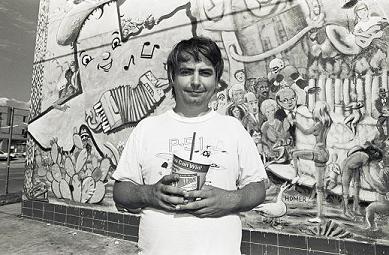

Sometimes, the best artists are the ones with the worst demons. Daniel Johnston may be one of these. Although he is not widely known, Johnston has a huge following in the music and art community, with the late Kurt Cobain, Sonic Youth, and the Butthole Surfers among his many fans. The Devil and Daniel Johnston, written and directed by Jeff Feuerzeig (Half Japanese: The Band That Would Be King), works for two reasons. The main one is that Johnston obsessively taped and/or recorded much of his life, giving viewers a first-hand look at many of his experiences. The second is that Johnston seemed to self-destruct at many points in his life, adding a wealth of drama. Think of this film as a mixture between Tarnation, Jonathan Cauotte's deeply personal film about his own life, and In the Realms of the Unreal, a documentary about outside artist Henry Darger.
People may not understand that music of Johnston, but that is not necessary to appreciate the movie. His songs are simplistic, almost child-like, which may turn off a lot of people. This reviewer wasn't too keen of the music itself. However, once one listens to the lyrics, one can appreciate the depth of his work. His lyrics reflect his tortured soul. Combined with the music, Johnston's songs prove a strange, moving experience. They are a product of his unique life. He grew up in Sacramento in an ordinary family. His parents and siblings were deeply religious, and his mother did not approve of his desire for art. He loved comic books, especially Captain America and The Incredible Hulk, and loved making short movies on his Super 8. Johnston's manic depression began in high school. Later, he ran away to join a traveling carnival, and later settled in Austin. There, he eagerly made music, copied cassettes, and handed out tapes to whoever would listen, slowly establishing himself.
The largest flaw in Feuerzeig's film is that it does not delve into Johnston's medical condition (probably out of respect for Johnston). The most the viewer learns is that it is manic depression. It would be nice to explore the factual side of things, but Feuerzeig makes up for this by extensively documenting the emotional side. He traces the effect that Johnston's condition had on his life, and in turn, on his music. The lyrics are contrastingly dark and light. Characters and themes reappear consistently. Johnston is a gifted writer (and later became a visual artist), which made his songs all the more compelling. His songs were honest and raw, and touched a nerve with many people who heard them. Feuerzeig captures the love that Johnston has for the art, then his medical condition arises and Johnston sabotages his own success. This happens repeatedly, and Johnston captured much of this on tape. The viewer can watch him self-destruct during an intimate concert full of A&R reps, or in what seems like a mad rage on the streets of New York. This is what makes The Devil and Daniel Johnston such a riveting film, and what garnered it the Director's Award at the 2005 Sundance Film Festival (as well as a nomination for the Grand Jury Prize). The film looks intimately at the highs and extreme lows of Johnston's life, laying it bare in front of the camera.